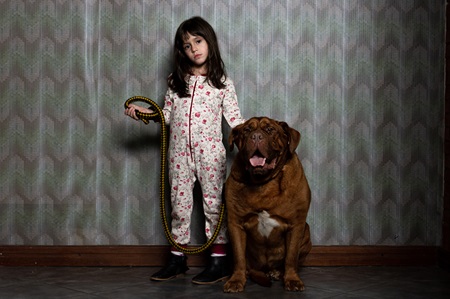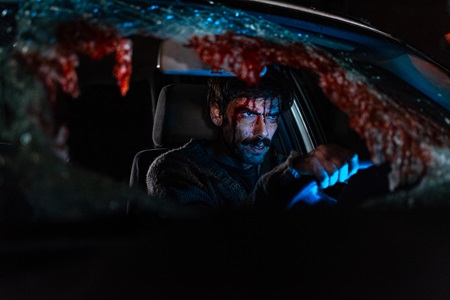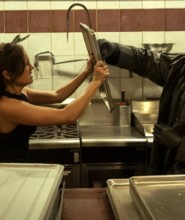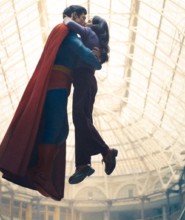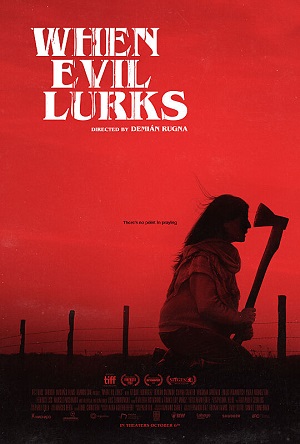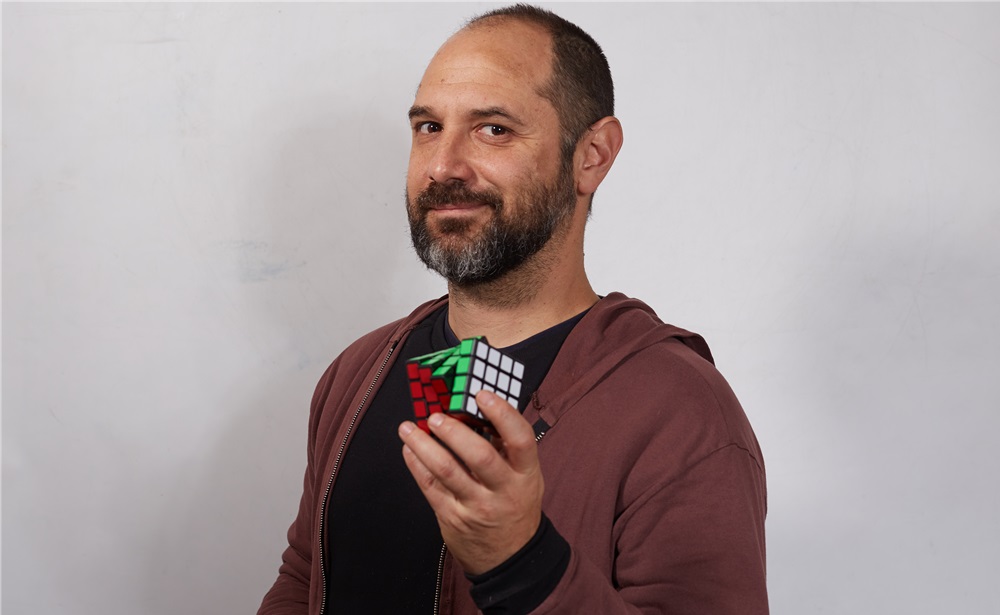
“When Evil Lurks” – Interview with Demián Rugna
by Sara Michelle Fetters - October 27th, 2023 - Features Interviews
Preferring Silence
Demián Rugna shakes up possession and exorcism clichés with the disturbingly masterful When Evil Lurks
Released to theaters on October 6 and making its Shudder debut today, the Argentinian possession thriller When Evil Lurks has become one of 2023’s most beautifully disturbing discoveries. Writer and director Demián Rugna’s latest cold-blooded horror effort throws genre convention on its head. It leans into the bleak depravity of its premise, showcasing levels of unapologetic violence and gore in its opening act that similar features would either save for the climax or go out of their way to eschew entirely.
The premise is straightforward enough. To pull from my theatrical review published last month, just outside of town in rural Argentina, ranch hands Pedro (Ezequiel Rodríguez) and Jimi (Demián Salomón) discover a mutilated corpse that then leads them to a squatting Indigenous family they’ve allowed to live on the land. The problem? One of them is possessed by a demon, and the dismembered body was the remains of a special type of exorcist who was on their way to “dispose” of the infected individual.
What follows is nothing short of abhorrently masterful, Rugna doing a magnificent job of sending his two main characters on a journey of unhinged calamity that’s frequently spectacular. I sat down with the filmmaker a couple of days before his film’s Shudder debut. Here are the edited transcripts of what he had to say:
Sara Michelle Fetters: I must say, as much as I enjoyed Terrified, When Evil Lurks blew me away.
Demián Rugna: Thank you. I appreciate it. I’m just trying to do the same that I’m trying to do from the beginning of my career: make horror movies for our audience. Trying to make good tales, good dialogues, and this is my formula. Obviously, it wasn’t great from the beginning, because I made three movies and nothing happened in my career. Fifteen years of trying to pay my taxes with movies and I couldn’t until I made Terrified. But, yeah, I’m happy. I’m happy for this moment.
SMF: What interested you in trying to tell a possession horror film? This is a genre where it is very difficult to make a good one. Even the new Exorcist [The Exorcist: Believer] fails at a certain point. But the original The Exorcist did fundamentally change this genre to a point where it has become very hard for filmmakers to have a fresh voice or discover a new angle of attack. With all of this being the case, what interested you in trying to tell a possession story, and how did you know you had an original and innovative way to tell it?
DR: It’s a really good question. The truth is all the time I am trying to make something fresh in my scripts. The point is when you watch an exorcism movie, you know what is going to happen. You know the priest is coming. You know they’re going to pray. The demon’s going to insult the priest and the crucifix. In the first 40 minutes of the movie, the priest won’t win.
My idea is, okay, what about if we kill the religion? What about if we kill the church and even we kill the exorcist? What we should do with the possessed then? Get rid of him! [laughs]
The creation of that idea gave me a lot of creative elements to explore. If you watch the movie, yes, it’s a possession movie, an exorcism movie, but really it’s a Greek tragedy. We are following the path of this father getting deeper and deeper and deeper into Hell.
SMF: You don’t add a lot of backstory. We know that things have happened in the past that people are aware of. People are also aware that the exorcist is, as you say, killed at the very beginning, so that’s not a spoiler. But you don’t explain or add a lot of backstory. You don’t fill in the blanks. You let the audience do that. Did you feel that there was a risk of leaving things too vague?
DR: I realized after I made Terrified that it’s too hard to invite the audience to a new world because they need an explanation. But they don’t need a lot of explanation from me. When I received the reviews for Terrified, I read a lot of really, really, really good [ones]. But, the critique many listed as a bad thing in that movie was, “But the director didn’t explain what is really happening. I need more explanation!” When I received the review for this movie, the bad reviews keep saying, “He explained a lot.” Which one is it? [laughs]
Now I realize the explanation of the myth is something that you never convince all the audience. But the point is, honestly, when you create a new world as I create them, even in Terrified, the audience is not prepared easily for this new world. They want the cemetery to be under your house. They want an Indian burial ground. You say that, and now you have the answer for all the audience. You don’t need to explain anything more.
Look at the poster you have on your wall: Star Wars. When you watch Star Wars, you start to watch in the middle of the mythology. Star Wars didn’t explain. Something happened with the Empire and the Rebels. Now you are in the war. You are in this universe. It starts in the middle and you’re good with that. You know what happened without knowing what happened.
And that is something similar that happens in my movie. You can start in the middle because you already know the beginning.
SMF: The other thing that you do is, very early on, you let the audience know that you’re not going to take it easy on them. You’re going to show some really, really brutal and tough stuff, and it’s only going to get worse.
DR: Yes.
SMF: How do you know how far you can push that? Is there a line you can’t cross?
DR: The first scene has to be a brutal scene. It’s trying to say, “I’m not joking.” This mythology, this demon, the characters, I mean the people saying something is going to happen or something terrible is going to happen, they are not joking. I’m showing in front of your eyes why they are so scared. After that scene, now I am as director, I am the driver of this school bus going to the hill and you are inside. So, I don’t know if there’s a line.
For me, it’s a horror movie. I’m not polite for the horror movies. I prefer to watch a cruel horror movie, but I need a good script. If you have a script, if you have a story, there’s no limit for me, I guess. I never make a movie without a solid script, without a solid tale. I choose to take a lot of risks in making this movie. But I also got lucky. I guess we are all lucky, all of us who made it, that this movie has a lot of freedom. This is great, that freedom.
SMF: Let’s talk about that script. It’s rare that a horror film takes these kinds of risks and is as great as it ends up being. It’s very few filmmakers who can get away with just ambiance, style, and visuals alone. Lucio Fulci could get away with it.
What makes this movie work is that Pedro and Jimmy, they are real brothers dealing with something believably tangible. Ezequiel Rodríguez and Demián Salomón are just phenomenal in these roles. For you, as the writer, how did you make sure and craft these two really compelling, if sometimes very stupid, characters for us to emotionally latch on to so completely?
DR: I guess I could choose to make a woman in the role of Pedro but, for me, it is stronger to have a fragile guy trying to save his family. My real intention was to share a story of two brothers when they are scared, fragile. One of them, Pedro, is fighting against his own demons. Running away from his own demons. At the same time, he’s also running away from a real demon!
Both actors, they make it possible, they are these characters. That’s the truth. They add a lot of things. They add a lot of ideas. I owe them a lot, Ezequiel and Demián. They’re great.
SMF: I just have a couple of quick additional questions for you. The first is, have you been surprised at all by the almost universal acclaim and the audience adulation for this film? Internationally, not just in Argentina? It’s kind of become something of an October phenomenon.
DR: I’m surprised, but I did do this movie for this result. I did it because I trusted this script. But it is a big surprise, because this is an actual Argentinian movie. You are watching this movie with subtitles, and even with our culture, our landscape, and still it became universal. That is great. I didn’t need to make a Hollywood movie for this situation and this is weird. I’m surprised by that.
Honestly? I thought, yes, it’s to be a good success. But I thought in festivals, probably not with the audience in general theaters. It’s incredible. Just incredible. I took a lot of risk because I trust it was going to work. But sometimes, even when it works, this sort of reaction still does not happen. My previous movie before Terrified [You Don’t Know Who You’re Talking To], audiences loved that movie. But nothing happened. There’s been no distributors, and nobody knows about that movie.
SMF: As for those audiences watching the film, what do you hope they’re talking about when they walk out of the theater?
DR: For me, I prefer them to be silent, because this is the internal moment to absorb the entire movie. If they are joking after the movie, I don’t want that. I prefer they not talking, not laughing. I prefer the silence. I want them to go home to go to sleep and not be able to. That’s what I prefer.
